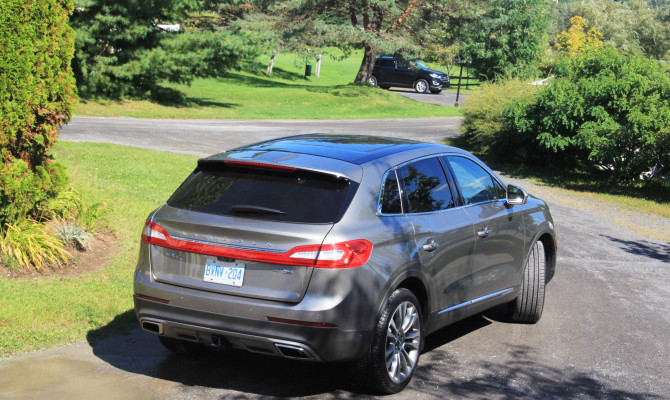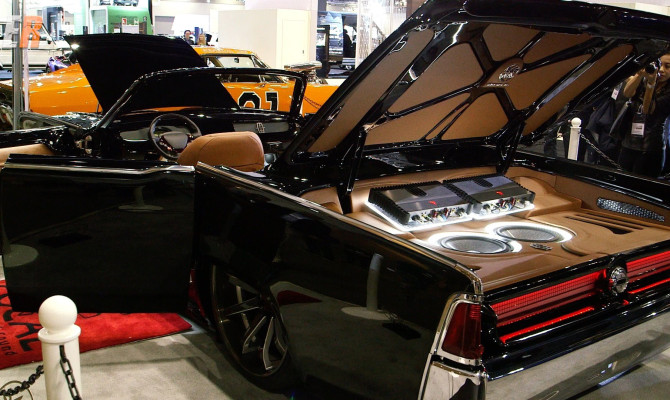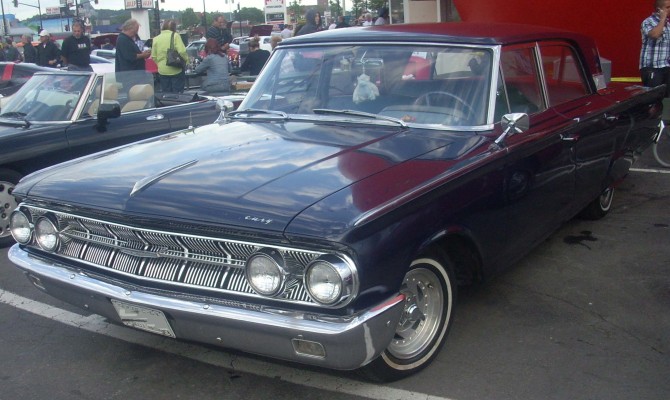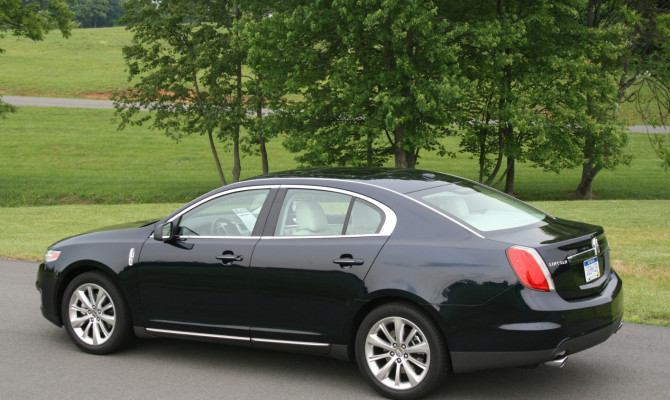And it has a curbside presence that manages to exude the quiet luxury that is the company’s mantra; the Continental is a beautiful ride, whether you are driving or being driven.
“Like most vehicles in this class, numerous helpful driver safety aids are available for the MKX and include adaptive cruise control, lane-keeping system, blind spot information system and cross-traffic alert.”
Montreal, Quebec.
The Lincoln brand has been on a sales revival roll of late, especially since we discovered that movie star Matthew McConaughey is, and long before anyone paid him to drive them, captivated by Lincoln vehicles.
Well, he’s got another one to drool over now, the all-new Lincoln MKX.
The midsize premium utility segment, where the new Lincoln MKX will circulate, represents a whopping 25 per cent of all luxury market sales in Canada. That’s a far bigger (percentage-wise) chunk of the premium auto pie than this segment draws in the US. Additionally, the MKX is made in Canada and rides on a new CD4 platform that it shares with the Ford Edge.
The second generation (first generation debuted as a 2007 model) redesign, however, moves this MKX even further away from its Ford family ties. The new body is lower and wider with curvaceous sculptured lines above the front and rear wheel openings. Up front, a new rendition of the Lincoln split-wing grille can come with adaptable LED headlights with blade-like projectors that aligned with the new horizontal grille bars.
Not only do the new LED headlights look sharp, they also provide better light. At speeds below 56 km/hour, LED reflector elements provide a wider and lower beam pattern. At higher speeds the light is re-focused to project further down the road.
The Lincoln MKX drive experience is primarily about comfort, quietness and abundant power, which the new optional 2.7 litre V6 EcoBoost engine certainly provides. It can deliver up to 330 hp, yet what’s most impressive about this engine is its silky, smooth V8-like performance with beefy torque output (up to 370 lb-ft), especially at low engine speeds. The carry-over base engine is a 3.7-litre, 300-hp V6.
That said, MKX buyers will pay a hefty premium for the 2.7-litre twin-turbo engine. Pricing for a 3.7 MKX starts at $45,890, but it jumps to $53,940 for the 2.7 EcoBoost version. Then again, that’s still a bargain compared to Euro competitors like a BMW X5 ($65,500 to $85,200) or a Mercedes-Benz GLE ($63,200 to $81,100).
Our test-drive tour through the Eastern Townships of Quebec confirmed that the MKX is a worthy wearer of the Lincoln badge. This picturesque area of La Belle Province is dotted with quaint little villages huddled around magnificent church buildings. Many of the roads, however, still bear the scars of those bitterly cold winters that Quebecers are accustomed to enduring.
The new integral link rear suspension, as well as the body structure and chassis upgrades, passed the rough-road challenge with aplomb. The MKX comes standard with Lincoln Drive Control, a suite of ride-enhancing technologies and it offers three driving modes (Normal, Sport and Comfort). The Lincoln “Intelligent” all-wheel drive system is also standard, as is a new adaptive electric power-assisted steering system that can change both steering feel and quickness, dependent on a number of operating factors.
While I prefer a shift lever of some type, the push-button transmission selector on the dash does give the MKX interior a sleek, uncluttered appearance. The selector connects to six-speed automatic transmission (both engines) and shifts can also be made via paddles on the steering wheel. City/highway fuel economy is rated at 14.7/10.3 L/100km (3.7L V6) and 14.1/9.7 L/100 km (2.7LV6).
Clever, under-console storage has also been created and super comfy 22-way adjustable front seats are a new option. These seats come with an active motion massage feature for the upper legs and lower back via six adjustable air bladders. They also come with four-way power head restraints and power thigh extenders.
If parking is not your favourite pastime Lincoln MKX has a couple of new technology solutions. An enhanced park assist system, offers 360-degree camera coverage to provide a birds-eye view of the vehicle (and up to almost two metres all around it), making any low-speed parking situation easier. An even more advanced “auto-pilot” parking system, with 12 ultrasonic sensors, can now guide MKX into a perpendicular parking stall, in addition to parallel parking assist and park out assist.
Like most vehicles in this class, numerous helpful driver safety aids are available for the MKX and include adaptive cruise control, lane-keeping system, blind spot information system and cross-traffic alert. A new pre-collision assist system helps avoid or lessen the severity of frontal impacts with another vehicle, or a pedestrian.
“Also confirmed is a one-of-a-kind 1970 Chevelle, which achieves speeds of zero to 100 km/h in around 4.5 seconds.”
A heavily customized 1963 Lincoln with an assessed value of a million dollars makes its free show debut this weekend.
It will be one of more than 350 premier, classic, muscle and specialty vehicles gathering at the Hard Rock Casino in Coquitlam on Saturday (July 18) for the second annual Ultimate Car Show.
This free community event, put on in partnership with custom car company, 360 Fabrication Inc. of Abbotsford, will take place from 2 p.m. until 4 p.m. in the casino parking lot.
Some of the best exotic, classic, and muscle cars in Western Canada are already registered o participate. 360 Fabrication owner Rick Francoeur is looking forward to showing off custom treasures. Also confirmed is a one-of-a-kind 1970 Chevelle, which achieves speeds of zero to 100 km/h in around 4.5 seconds, and one of the world’s most highly modified muscle cars – a 1967 Mustang Fastback, which boasts roughly 700 individual modifications.
Car culture and music fans will also be excited to know that the Hard Rock is also featuring a concert by internationally known band Count’s 77, whose lead singer Danny “Count” Koker stars in History Channel hit Counting Cars.
British Columbia’s SCRAP-IT Program has announced a new incentive program aimed at removing high polluting vehicles from our roads, on the eve of this year’s Vancouver International Auto Show. (more…)
“In the last couple of years, the “Have faith in Lincoln restoration campaign” has been in full swing.”
Faith is a concept not exclusive to religion.
The principle of faith is to believe in things that haven’t been seen. Then there is the loss of faith. Perhaps the lack of seeing, and the abundance of waiting, left other opinions to be formed in the waiting period.
Lincoln is a brand in which many lost faith. Its association with lacklustre quality, the stigma that only individuals who are in the latter stages of life drive a Lincoln, and the fact that there is dwindling brand appeal, didn’t help its cause.
In the last couple of years, the “Have faith in Lincoln restoration campaign” has been in full swing.
With strong products, ones that appeal to both the eyes and enthusiast, they’re coming back strong. But are these traits enough to bring a younger demographic into the fold?
With the launch of its small, premium utility vehicle, the MKC, it’s certainly a huge stride in the right direction. It’s all-new for 2015 and starts at an MSRP of $39,940.
The MKC is the first vehicle to be designed from the ground up in a dedicated Lincoln studio, and I think they’ve done a great job. From its classic and signature split wing grille, to its tight lines, to its overall form, I’m impressed.
As you slip inside its spacious and inviting interior, you’ll notice the absence of a large gear selector near the centre console. That’s because it’s integrated into the stack and you operate it via the push of a button.
While some have a very polarized opinion on this feature, I didn’t mind it at all. Yes, I reached for a gear selector that wasn’t there a few times and confused my passengers, but after a few times behind the wheel, it made sense why it was there.
The centre stack has a streamlined-nature to it. The buttons and touch screen blend effortlessly. Of course, when the touch screen is off you can see all the fingerprints but a soft cloth fixes that!
Aside from its aesthetics, the MKC does drive and handle very well. Based on the Ford Escape, this 5-passenger vehicle comes equipped with two different engines. The first is a 2.0L, EcoBoost 4-cylinder with 240 horsepower and 270 lb-ft of torque. Then there’s an optional 2.3L, EcoBoost 4-cylinder with a spirited 285 horsepower and 305 lb-ft of torque. It’s then matched with a 6-speed automatic transmission.
The MKC, regardless of engine choice, comes with an all-wheel drive (AWD) setup.
Whether at speed or crawling along in the city, the electric power-assisted steering (EPAS) has been calibrated to give the driver enough feedback that it doesn’t feel lazy, but has enough resistance to make the commute a pleasant one.
Combined with its suspension, which is an independent MacPherson strut-type up front and a fully independent multi-link with stabilizer bar around back, you have a recipe for an MKC that handles the turns with poise and confidence.
Estimated fuel consumption numbers come in at 12.9L/100km in the city and 9.2L/100km on the road. According to the trip computer, which I zeroed after picking the vehicle up, it said I was averaging 15.7L/100km. Yikes. I didn’t think I had that much of a lead foot, but I wasn’t driving the vehicle hard. And my daily routines consist of both city and highway driving. This figure wasn’t as impressive as I had hoped for.
Aside from not-so-amazing fuel results, I was quite happy with the MKC’s cargo capacity. With the rear seats up, you’re looking at 712L. With the rear seats folded, there’s 1,505L to work with. It’s perfect for larger items like my road bike! I didn’t even have to take the front wheel off to fit it inside. Bonus.
Then there are such features like the panoramic vista roof, the heated and cooled front seats, a THX audio system, and active park assist to make the vehicle even sweeter.
Despite the plethora of options – there were $14,230 worth, for a test price of $55,920 with the $1,750 delivery charge included – the MKC doesn’t need to be loaded with them to the max to make it a worthwhile vehicle to drive. It does have some tough competition, like the Audi Q5, Acura RDX, BMW X3 and Mercedes-Benz GLK, but it can hold its own and does a great job of ensuring a great driver’s experience.
Visit www.lincolncanada.com for more information.
Contact: alexandra [dot] straub [at] drivewaybc [dot] ca
“There’s a huge incentive for auto manufacturers to try to introduce unique trucks in an effort to expand their existing model lines and fatten corporate treasuries.”
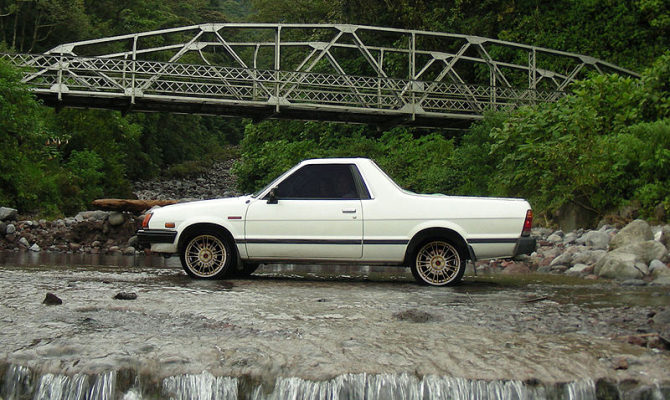





by Larry Pintz
Over the past two decades, America has become a land of truck drivers as SUVs, crossover SUVs, minivans and pickups have grown to account for the majority of light vehicle sales in the United States. In fact, the most popular vehicle in the world for more than three decades has been the Ford F-150, which, according to Morgan Stanley, accounts for 90 percent of Ford Motor Company’s global profits.
Given that kind of profit margin, and considering that in a typical year 16 million new vehicles are sold, there’s a huge incentive for auto manufacturers to try to introduce unique trucks in an effort to expand their existing model lines and fatten corporate treasuries.
For the most part, these efforts succeed. Neither a Cadillac Escalade nor a BMW X5 seem as strange as they did a decade ago. But here are other efforts that seemed like a sure bet but somehow missed the mark.
1978 Subaru Brat/2003 Subaru Baja
The product plan: Chevy was reaping fat profits with its rear-wheel-drive, midsize, car-based El Camino, as was Ford with the Ranchero. Subaru took the plunge with the four-wheel-drive Brat. The carmaker repeated their folly with the 2003 Baja.
So what happened? Brat stood for “Bi-drive Recreational All-terrain Transport.” Based on the company’s compact sedan platform, the Brat’s practicality was limited by two rear-facing seats mounted in the cargo bed, which offered little protection from weather or accidents. The Baja was a similar effort, minus the cargo bed seats.
1982 Dodge Rampage
The product plan: Like Subaru, Dodge eyed the fat profits made by Chevy and Ford with their car-based pickup trucks and designed the Rampage to fill the void. Unlike the Subaru, there were no chairs in the cargo bed.
So what happened? In light of the second Mideast oil embargo, Dodge converted their product line to front-wheel drive. So, the Rampage was built on a compact, front-wheel-drive car platform with four-cylinders. However, domestic buyers expected their trucks to have eight cylinders. Result? – This tiny truck’s name was a ruse.
1989 Dodge Dakota Convertible
The product plan: Since truck buyers increasingly use their vehicles as lifestyle accessories, why not offer the ultimate four-wheel fashion accessory, a convertible pickup?
So what happened? You have to admire then-Chrysler CEO Lee Iacocca and crew for offering something that had never been tried. Nevertheless, whether bought for image or utility, trucks have to look as is they’re ready to work. By contrast, droptops must look seductive. The Dakota offered neither.
2001 Pontiac Aztek
The product plan: Design a car-based crossover SUV with Pontiac design cues hung on a minivan platform to give the vehicle a sense of excitement while saving development costs. Then, name it after a dead civilization, but misspell the name.
So what happened? This is a car that made sense only inside the airless world of GM’s numerous corporate committees. That said, the Aztek has one interesting idea: the center console doubles as a removable cooler. Other ideas, such as the optional tent, were regrettable. And need we mention the styling?
2002 Lincoln Blackwood
The product plan: Casting a jealous eye at the success and profitability of the Cadillac Escalade, in reality little more than a leather-lined Chevrolet Tahoe, Lincoln did the same to its bestselling Ford F-150 pickup.
So what happened? At the time, Ford’s CEO, Jacques Nasser, didn’t fully understand the American market, which might explain why the cargo bed was lined with carpet. Even worse, the cargo bed cover was permanently attached; so it was better at hauling polo mallets than cargo pallets. Ford lost millions on this truck.
2004 Chevrolet SSR
The product plan: Chevy unleashed this convertible pickup concept truck at the height of Detroit’s obsession with retro styling. It elicited such a positive reaction at auto shows that Chevy chose to build it. Given Chevy’s lineup at the time, it’s no wonder.
So what happened? The old saw about those who do not learn from history being doomed to repeat it applies here. While the SSR looked better than the Dakota convertible, its miniscule 4-foot cargo bed rendered the truck useless. Toss in lots of chassis flex and a lofty $40,000-plus price tag, and its fate was assured.
Larry Pintz writes for Hagerty, the world’s leading specialist provider of classic car and boat insurance. Learn more at hagerty.ca.
“It delivers on space, comfort and functionality while driving like a smaller SUV…”
The 2015 Lincoln Navigator is a people mover designed for those that like to arrive in style.
Looks:
The Lincoln Navigator makes a statement wherever you take it. The bold split grille with the integrated front bumper and blended in driving lights brings style to the front of this truck. The body lines help split up the large side body panels. A large LED brake light stretches across the power lift gate and wraps around each corner giving it an interesting look while making it very visible when the brakes are applied. Another feature I found very cool was the welcome mat. When you press the unlock button on the remote the Lincoln logo illuminates the ground.
In The Cab:
As you open the door to climb in the cabin, power deployable running boards to help you get in greet you. Don’t stand too close though because they come out right at ankle height! Inside you can choose the optional Trevino leather seats, leather door trim and console accented by Ziricote wood inlays. The dash is hand warped and stitched giving this cabin a very upscale look. The front bucket seats can be heated or cooled. The second and third rows fold flat with the touch of a button. Both models carry eight passengers. SYNC with My Lincoln Touch is a command centre that control everything from entertainment to climate. Speaking of entertainment, the sound system is a THX 11 certified 5.1 surround system that features 14 speakers and 600 watts of power.
Safety first:
Front seat mounted side airbags, safety canopy system with side curtain airbags and rollover sensor. Advance-Trac with roll stability, tire pressure monitoring system, and trailer sway control are just some of the standard features on the Navigator.
Roadworthy:
This large SUV is perfect for the whole family. It delivers on space, comfort and functionality while driving like a smaller SUV. Very little, if any, body roll. Steering is magnificent and easy while responsive to changing lanes and finding a tight parking space.
Verdict:
You may not drive it to be cool, but you can’t help looking cool driving down the road.
Power:
This vehicle comes standard with a twin turbo 3.5L EcoBoost V6 engine that puts out 380 horsepower and 460 lb ft of torque. The transmission is a six speed select shift. 4.10 gear ratio. Towing is made easy with the transmission tow/haul mode, which helps keep you from gaining too much speed when towing downhill. The engine maintains its power band while towing up a hill keeping the speed and momentum constant.
Pump frequency:
16.2 / 11.8 L/100 km (city/highway) Navigator 4X4
16.2 / 11.8 L/100 km (city/highway) Navigator L 4X4
Warranty support:
Basic 4 years / 80,000 km
Corrosion 5 years / unlimited distance
Powertrain 6 years/ 110,000 km
Safety restraint 5 years/ 100,00km
Sticker price:
100A $75,110
L 100A $78,110
101A $82,360
L 101A $85,360
“Black Label vehicles will come fitted with one of four designer-inspired interiors that will feature ultra-posh Venetian leathers, Ziricote wood and Alcantara suede…”
Not all the action took place on the floor of the Los Angeles auto show.
At a mansion, high in the ritzy Hollywood Hills neighbourhood, Lincoln hosted a classy special event to launch its Black Label edition vehicles for the well-to-do. (more…)
Multi-national Ford Motor Company has charted a quite conservative path through the years.
Unlike dedicated eccentrics SAAB, Citroën and even American Motors, Ford has produced few cars that could be characterized as weird, but here are five from Ford (and its Lincoln and Mercury divisions) that still have us scratching our heads…
1982-85 Ford Escort EXP
The EXP (along with its twin the Mercury Lynx LN-7) was simply bizarre. It was supposed to be a sporty two-seater version of the Escort compact, but the styling was incomprehensible. It was touted as a modern, affordable and efficient version of the concept that brought the car world the classic two-seater 1955-57 Thunderbird. But where the T-Bird was graceful and elegant, the EXP was just odd, and the squinty, hung-over look to the headlight treatment was particularly strange.
1963 Mercury Monterey Breezeway
The Monterey and its predecessor, the Turnpike Cruiser, were standard 1950s and 1960s full-size Ford Motor Company products, but it was the backward-slanted rear roofline and a rear window that lowered for ventilation that added a truly strange look to the car, as well as providing ready ingress for exhaust fumes.
2002 Lincoln Blackwood
The Blackwood was a one-year-only Lincoln luxury pickup designed to compete with the Cadillac Escalade XLT. Unfortunately, it turned out to be the answer to a question that nobody was asking—a shortbed luxury pickup that was too nice to haul anything. Less than 3,500 were made in that single year.
1959-67 Ford Anglia 105E
Famous as the flying car from the “Harry Potter” series, this English Ford sported a distinctly American feature — the bizarre, backward-slanted rear window that Lincolns and Mercurys had sported in the U.S.
1996-08 Ford Ka
Another odd duck Ford not seen in the U.S, the Ka was both an oddly named and strangely styled city car that measured just over 142” overall. Performance was largely theoretical as the Ka was powered by a derivative of the ancient four-cylinder that powered the Anglia. Handling was at least said to be entertaining.
Rob Sass is the vice-president of content for Hagerty Insurance. Hagerty is the world’s leading specialist provider of classic car and boat insurance. Learn more at hagerty.ca.
“Lincoln’s interior theme for the MKS was guilt-free luxury as recycled wood (from reclaimed furniture) was used to make the decorative trim pieces inside the cabin.”
The MKS is not just another big Lincoln; it’s an slick ultra-modern full-sized sedan.
It was introduced for the 2009 model year and came with just about every new high-tech auto gadget. Unlike the big engine, gas-guzzling Lincolns of yore, a modern V6 engine powers MKS.
Both front-drive and all-wheel-drive (AWD) versions of MKS are available. The ‘09’s 3.7-litre V6 is a four-valve per cylinder engine with variable valve timing that can deliver 273 horsepower and 270 lb.-ft. of torque, on regular-grade gasoline. The front-drive version should consume about 14.0 /9.9 L/100 km (city /highway – new adjusted rating) and the AWD edition drinks an additional half-litre of gas every hundred kilometres.
The transmission is a six-speed automatic transmission with an auto sport-shift feature and it also has a sequential manual mode feature. The optional all-wheel-drive (AWD) system defaults to a front-drive mode in normal driving situations, but it can send up to 100 per cent of drive to either the front or rear axle, if needed.
The standard equipment list includes stuff like a front park assist system, intelligent start (a keyless ignition system), adaptive headlamps (that move with steering) and a power rear window sunshade that has an auto retract feature when the MKS is put in reverse. Options came in packages like the popular ($5,000) Vision package that included a navigation system plus adaptive cruise control, a rear back-up camera and a superb THX II 5.1 surround sound audio system.
Inside, the MKS has a roomy cabin. Rear seat head and legroom is excellent and they even come with electric heaters. The trunk is another extra-large offering with 521-litres (18.4 cubic feet) of cargo space.
Lincoln’s interior theme for the MKS was guilt-free luxury as recycled wood (from reclaimed furniture) was used to make the decorative trim pieces inside the cabin. An eco-friendly (chromium-free) tanning process is also used by the Scottish leather supplier to give its “Bridge of Weir” upholstery an extra soft feel.
A second engine choice was added for the 2010 model year, transmission shifter paddles come with a new steering wheel and a MyKey security system became standard. The new 3.5-litre “EcoBoost” turbocharged direct-injection V6 engine, offered more power, yet provides about the same fuel economy, as the base 3.7 litre V6 and came as part of a new GTDI trim level. No other running changes of significance were made to MKS for the 2011 or 2012 model years.
Higher than average repair problems, particularly with the braking system, show up on the Consumer Reports reliability surveys, but average to good ratings in most other areas has allowed the MKS achieve an overall “average” reliability history rating. Crash safety ratings for the MKS are excellent and it’s an overall “Top Pick” in its class, according to the Insurance Institute for Highway Safety.
A pre-owned Lincoln MKS is an even more attractive purchase when you consider that it probably cost in excess of $50,000, when brand new, to put it on the road. A used MKS can be a good buy, especially if you plan to do some long distance driving.
**********
Price Check: 2009 to 2012 Lincoln MKS (Sept 2014)
Year Edition Expect to Pay Today
2009 MKS $15,000 to $19,000
2010 MKS $19,000 to $23,000
2011 MKS $24,000 to $28,000
2012 MKS $29,000 to $34,000
Prices vary depending on a used vehicle’s condition, mileage, usage and history. A complete mechanical check should always be performed by a reliable auto technician prior to purchase.
**********
Safety Recalls: 2009 to 2012 Lincoln MKS:
2012 – The fuel tank may have been manufactured incorrectly and may not provide the expected strength in the event of an impact, and may leak. A fuel leak may also occur even in the absence of an impact. Dealers will inspect and, if necessary, replace the fuel tank.
Recent Comments
- { Enjoyed your Forest of Bowland in the BMW X5M, particularly the photo of the BMW in front of the main part of Stonyhurst College where... }
- { Bantam designed the Jeep, not Willy's or Ford. The American military gave the original Bantam prototype to Willys and Ford to copy. There is plenty... }
- { All Escalades come with a 6.2-lilter V8 engine that produces 420 horsepower. A six-speed automatic is the only transmission offered and drives the rear wheels.... }
- { Alexandra is an excellent journalist. }
Popular Posts
- Journey to a ‘Sparkling’ Luxury Okanagan Resort “Four lucky readers will put a Dodge Journey’s weekend-...
- The Need For Speed: Hike Those Highway Limits More than half of those polled believe the province sho...
- Drives-U-Crazy… Erratic drivers. An early morning drive from Kelowna to Vancouver is nor...
- Readers Respond: The Pros and Cons of Increasing B.C. Speed Limits Increasing the speed limits will only increase risk to...
- Honda CR-V Review: The Compact Crossover To Get Things Done The CRV is a very stylish and aerodynamic crossover veh...




